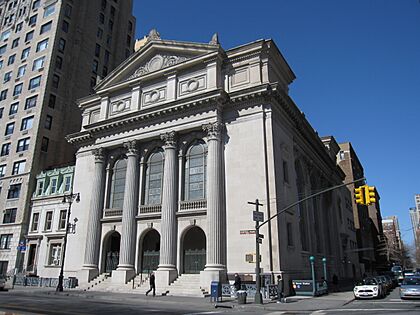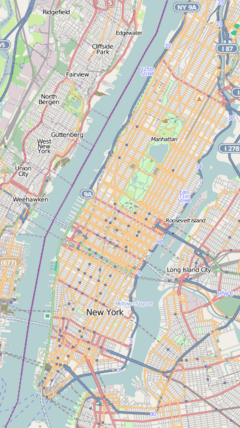Congregation Shearith Israel facts for kids
Quick facts for kids Congregation Shearith Israel |
|
|---|---|
|
Hebrew: קהילת שארית ישראל
|
|

Congregation Shearith Israel at Central Park West
|
|
| Religion | |
| Affiliation | Orthodox Judaism |
| Rite | Nusach Sefard |
| Ecclesiastical or organizational status | Synagogue |
| Leadership |
|
| Status | Active |
| Location | |
| Location | 2 West 70th Street, Upper West Side, Manhattan, New York City, New York |
| Country | United States |
| Architecture | |
| Architect(s) | Arnold Brunner |
| Architectural type | Synagogue |
| Architectural style | Neoclassical |
| Date established | 1654 (as a congregation) |
| Completed | 1897 |
| Direction of façade | East |
The Congregation Shearith Israel (Hebrew: קהילת שארית ישראל, romanized: Kehilat She'arit Yisra'el, lit. 'Congregation Remnant of Israel'), often called The Spanish and Portuguese Synagogue, is an Orthodox Jewish synagogue located at 2 West 70th Street, at Central Park West, on the Upper West Side of Manhattan in New York City, New York, United States.
Established in 1654 in New Amsterdam by Jews who arrived from Dutch Brazil, it is the oldest Jewish congregation in the United States. Until 1825, when Jewish immigrants from Germany established a congregation, it was the only Jewish congregation in New York City.
The Orthodox congregation follows the Sephardic rite, and has occupied its current Neoclassical building since 1897.
Contents
Founding and synagogue buildings
The first group of Spanish and Portuguese Jews were twenty-three refugees from Dutch Brazil, who arrived in New Amsterdam in September 1654. After being initially rebuffed by anti-Semitic Director of New Netherland Peter Stuyvesant, Jews were given official permission to settle in the colony in 1655. This year marks the founding of the Congregation Shearith Israel. Although they were allowed to stay in New Amsterdam, they faced discrimination and were not given permission to worship in a public synagogue for some time (throughout the Dutch period and into the British). The Congregation did, however, make arrangements for a cemetery beginning in 1656.
It was not until 1730 that the Congregation was able to build a synagogue of its own; it was built on Mill Street (now William Street) in lower Manhattan. The Mill Street synagogue was said to have had access to a nearby spring which it used as a mikveh for ritual baths. Before 1730, as noted on a 1695 map of New York, the congregation worshipped in rented quarters on Beaver Street and subsequently on Mill Street. Since 1730 the Congregation has worshipped in five synagogue buildings:
- Mill Street, 1730
- Mill Street rebuilt and expanded, 1818
- 60 Crosby Street, 1834
- 19th Street, 1860
- West 70th Street, 1897 (present building)
The current building was extensively refurbished in 1921.
Founding major Jewish institutions
As the American Reform Judaism made headway in the late 19th century, many rabbis critical of the Reform movement looked for ways to strengthen traditional synagogues. Shearith Israel, and its rabbi, Henry Pereira Mendes, were at the fore of these efforts. Rabbi Mendes cofounded the American Jewish Theological Seminary (JTS) in 1886, in order to train traditional rabbis. The school held its first classes at Shearith Israel. In JTS' earliest days, it taught and researched rabbinics similarly as was done in traditional yeshivas, in contrast to the Reform Hebrew Union College.
Twelve years later, in 1896, Mendes was acting president of JTS. He promoted the formation of the Union of Orthodox Jewish Congregations of America (commonly known as the OU, the Orthodox Union). This synagogue umbrella group provided an alternative to the Reform movement's Union of American Hebrew Congregations.
As JTS grew, it needed better financing and a full-time head. The seminary moved to its own building, and Mendes was replaced by Solomon Schechter. However, Schechter developed a less traditional approach, which became the basis for Conservative Judaism (called Masorti outside North America). Initially there was considerable cooperation between the Orthodox and Conservative groups but, over time, the divide became clearer.
Schechter formed the United Synagogue of America (now the United Synagogue of Conservative Judaism, or USCJ) to promote synagogue affiliation with his conservative ideology.
Shearith Israel remained aligned with the Orthodox tradition. It eventually repudiated its association with JTS. In a sense, Shearith Israel helped create three of the largest and most significant Jewish religious organizations in the United States: JTS, the OU, and USCJ. Shearith Israel remains a member only of the Orthodox Union.
Clergy
Rabbis
The following individuals have served as rabbi of Congregation Shearith Israel:
-
Order Name Term started Term ended Time in office Notes 1 Benjamin Wolf 2 Gershom Mendes Seixas Not ordained: Hazzan of the Congregation and an ardent American patriot; he moved the Congregation to Philadelphia after the British occupied the city during the American Revolutionary War. 3 Moses L. M. Peixotto Not ordained 4 Isaac B. Seixas 1828 1839 10–11 years 5 Jacques Judah Lyons 1839 1877 37–38 years 6 Henry S. Jacobs 1874 1876 2 years 7 Henry Pereira Mendes 1877 1920 42–43 years 8 David de Sola Pool 1907 1919 45–46 years Hired as assistant rabbi in 1907, and left in 1919. A year later, Mendes retired, and the synagogue went through a succession of candidates until he returned in 1921. Herbert Goldstein was announced as rabbi, but did not actually take the pulpit. Reverend Joseph Corcos was appointed interim rabbi. 1921 1955 9 Louis B. Gerstein 1956 1988 31–32 years 10 Marc D. Angel 1969 2007 37–38 years 11 Hayyim Angel 1995 2013 17–18 years 12 Meir Soloveichik 2013 incumbent 11–12 years
Parnasim
Notable parnasim include Luis Moises Gomez, Israel Baer Kursheedt, and Alvin Deutsch (1997–2001).
Hazanim
Notable hazanim include Gershom Mendes Seixas (1768–1776 and 1784–1816), Isaac Touro (1780), Jacques Judah Lyons (1839–1877), DanAbraham Lopes Cardozo (1946–1986), Daniel Halfon (1978-1980) and Albert Gabbai (1983–1986).
Prominent members
- Jacob Baiz – merchant and Central American diplomat
- Mark Blumenthal – physician, served as trustee of Shearith Israel
- Albert Cardozo – Justice of the New York Supreme Court
- Benjamin N. Cardozo – Justice of the Supreme Court of the United States, 1932–1937
- Philip J. Joachimsen – lawyer and Judge of the New York Marine Court
- Judith Kaye – Chief Judge of New York, 1993–2008
- Emma Lazarus – poet
- Commodore Uriah P. Levy – the first Jewish Commodore of the United States Navy
- Theodore W. Myers – New York City Comptroller
- Edgar J. Nathan – Manhattan Borough President and justice of the New York Supreme Court
- Selig Newman – Polish-born Hebraist and educator
- Mordecai Manuel Noah – American playwright, sheriff, diplomat, and journalist
- Isaac Pinto – prepared the first Jewish prayer book published in America, which was also the first English translation of the Siddur
- Jack Rudin – real estate developer
- Arthur Tracy – singer and actor
Gallery
-
The synagogue's third cemetery (1829–1851) is on West 21st Street near the Avenue of the Americas
-
Signatures of Michael Michaels and Gershom Mendes Seixas on Shearith Israel's "Shechita book", at Penn Libraries
See also
- First Shearith Israel Graveyard
- Jewish history in Colonial America
- List of New York City Designated Landmarks in Manhattan from 59th to 110th Streets
- National Register of Historic Places listings in Manhattan from 59th to 110th Streets
- Oldest synagogues in the United States
- Touro Synagogue





